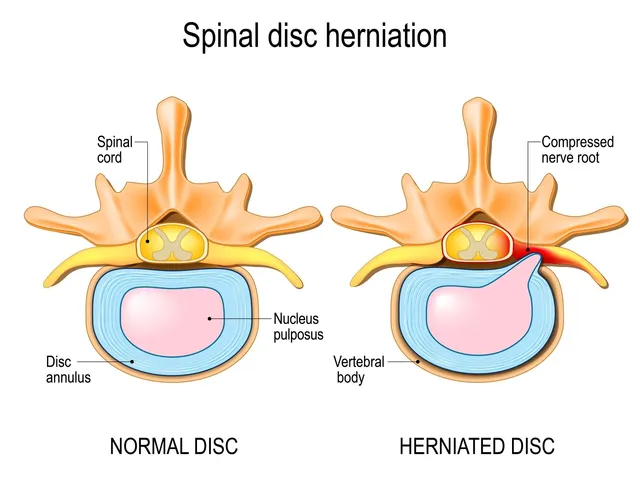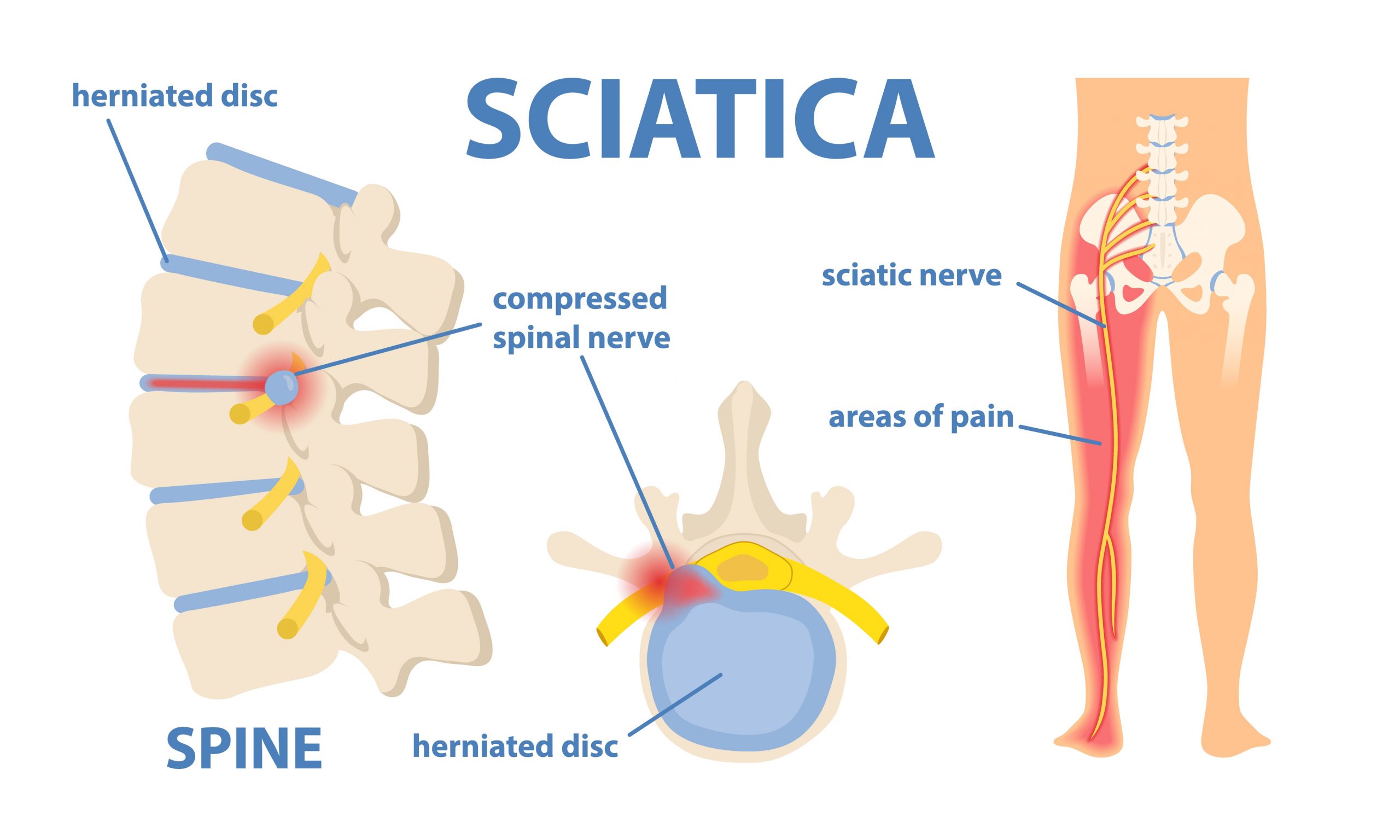What is Sciatica/Slipped Disc?
Human spinal cord is a very sensitive structure which comprise of millions of nerves/neural cells. This acts as a relay point between various organs and brain. All the information from joints, bones, nerves, ligaments and abdominal organs travel through spinal cord to the brain. It is protected by bones known vertebrae. There are 33 vertebrae in our spine and spinal cord runs in the centre of it. In between bones, there is a jelly-like highly complex magnificent structure called as “intervertebral disc” or simply called as “disc”. This acts as a shock absorber and provides cushion, flexibility to vertebrae.
When slipped disc happen due to various reasons (repetitive injury to the back, sudden jerk, weight lifting, old age, wear & tear, and even genetic cause), the supporting disc between vertebrae slip backwords and can compress either the spinal cord or the nerves that come out of a small opening on each side. This compression can be of varying intensity depending on severity of slipped disc. It typically happens in the lower lumbar spine and compresses the lower lumbar nerves which combine together to form a big nerve known as “sciatic nerve”. Hence, the terminology “sciatica”

What are symptoms/signs of Sciatica/Slipped disc?
Typically, Sciatica manifests as low back pain with goes down to the leg. Symptom severity varies from person to person and also depending on severity of slipped disc and consequent compression of spinal cord structures.
In the initial phase, symptoms are very severe ranging from back pain, spasm of back muscles, leg pain manifests as tingling, stabbing, electric-shock type, pulling of leg muscles and stabbing pain. Patients usually find it difficult to stand/sit longer and walking a short distance brings up pain. Most of the activities are painful leading to a poor quality of life.
There are few symptoms which we call as “Red Flags”, meaning life threatening or alarming and urgent attention should be given. These include excruciating pain, weakness or numbness in the legs, inability to control urination or defecation etc. These are indicative of “Cauda Equina Syndrome” means compression of spinal cord and needs urgent scanning and decompression surgery. Again, few other symptoms like sudden onset new pain, weight loss, loss of appetite, night sweat, fever are examples of “red flags” and should be thoroughly investigated.
Myths/Facts about Sciatica
A. Sciatica means we have to sleep on floor, stop using pillow or mattress.
This is absolutely incorrect. Sleeping on the floor or without mattress or pillow won’t reduce suffering or improve quality of life. Lumbar spine has a natural curvature known as lordosis. In acute sciatica, the pain is severe leading to spasm of back muscles leading to severe pain, and slight movement can exacerbate pain. Hence, a patient with Sciatica pain can very much use a normal size pillow and regular mattress for sleeping. Rather using a pillow below the knee can reduce lumbar lordosis, relax the lumbar paraspinal muscles and help in good sleep.

B .Patients with sciatica should take absolute rest for few weeks.
This is again a wrong concept. Unlike other illnesses, long period absolute bed rest is not advisable in sciatica patients. Bed rest for just 2-3 days at the most is advised but not beyond that. Initially, anti-inflammatory medicine, muscle relaxant, neuropathic medicine, physiotherapy with stretching and epidural steroid injection by pain physicians help tide over pain and inflammation associated with pain. Taking prolonged bed rest can cause atrophy of back muscles leading to weak spine and further pain. Hence, patients are advised to remain as active as possible including walking, moving around in the house, actively participating in the physiotherapy and rehabilitation process.
C . Surgery/Operation will provide long-lasting solution and cure the disease completely.
This is partially correct. Let me put a fact over here which is proven in many research covering thousands of patients with slipped disc/sciatica. Spine surgery is NOT the answer or treatment of choice in ALL patients with sciatica. A vast majority of patients (85-90%) with sciatica respond well and recover from sciatica with appropriate conservative treatment (anti-inflammatory medicine, muscle relaxant, neuropathic medicine, physiotherapy with stretching and epidural steroid injection). Only patients with cauda equine syndrome (excruciating pain, weakness or numbness in the legs, inability to control urination or defecation), those with extruded disc, spondylolisthesis (slippage of vertebrae over other), significant spinal canal stenosis or who have failed conservative treatment will benefit from surgery.
Another important thing to remember is spinal/back pain is not from slipped disc/sciatica, rather there are many other causes of back pain. Hence, even after a perfectly performed spine surgery patient can later experience back pain, and should not consider a surgery as failed one.
D. Sciatica pain will never go away.
A vast majority of patients experience very good relief in pain from sciatica. However, like any other illness back pain can recur. Back pain is complex and multifactorial. Hence, recurrence of pain in future may not be necessarily from sciatica. It can be from bad posture, trauma to spine, pain from facet joints, sacroiliac joints, muscles, nerve impingement or from abdominal organs. So, simply speaking life style measures, healthy diet, regular exercise, weight control, quitting smoking, and taking measures in preventing spine injury goes a long way in ensuring a good spine health and patients do not have to live with pain forever.
E. Sciatica can cause permanent nerve damage.
Permanent nerve damage from sciatica is uncommon but possible. Hence, patients who experience numbness in their legs, loss of control over urination or defecation should immediately seek medical attention. Spinal tumors or metastatic disease is another uncommon cause of possible neural damage but prompt treatment can reverse the nerve damage.
F. Epidural or Spinal injections provide temporary relief.
Epidural injections or nerve root blocks are non-surgical treatment options in acute slip disc which is performed in OT under X-ray machine guidance and is a day-care procedure. Patients are discharged in just 1-2 hours. This is the most commonly performed “spinal injection therapy” worldwide and plays a major role in reducing pain, muscle spasm and helping in rehabilitation and quick recovery.

Many studies have compared surgery with epidural steroid injection and at 1 year follow up, both groups have shown similar outcome. Hence, in majority of sciatica patients, epidurals provide tremendous benefit and when combined with life style care, posture care and others majors, it can even help in avoiding the spine surgery. Pain relief can last from few months to even longer time in patients. This procedure is devoid of any major side effects.
For More Discuss visit Neuron pain clinic
Read other spine and pain related blog at Neuronpainclinic
Check More videos on Neuron Pain clinic

